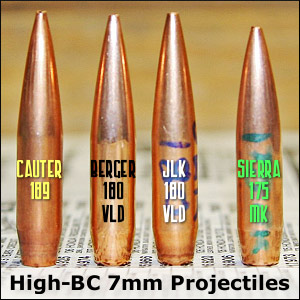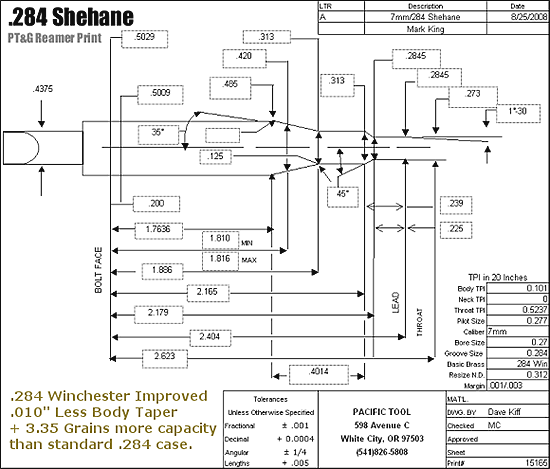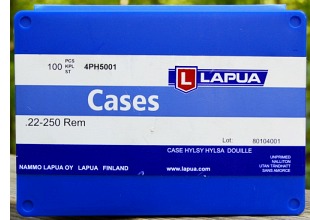|
|
May 20th, 2012
7mm has become the caliber to beat in F-Class open division. The dominant performances of UK shooters with 7mm cartridges at the 2009 F-Class World Championship, following the South African team’s success with 7mms at the previous Worlds, has shown the strength of 7mm chamberings for long-range competition. After losing to the Team Britain, the U.S. F-Open Team decided to switch to a 7mm for the next World Championship. While most of Britain’s top F-Class shooters were using WSM-based 7mm cartridges, you don’t need a short magnum to enjoy the wind-bucking abilities of a 7mm.
 With a standard .284 Winchester, or better yet, a .284 Improved, you can drive the high-BC Berger 180gr bullets to competitive velocities. A .284 Improved will shoot well inside a 6.5-284, and you’ll probably get 40-60% longer barrel life (at least 2000 rounds vs. as little as 1200). With a standard .284 Winchester, or better yet, a .284 Improved, you can drive the high-BC Berger 180gr bullets to competitive velocities. A .284 Improved will shoot well inside a 6.5-284, and you’ll probably get 40-60% longer barrel life (at least 2000 rounds vs. as little as 1200).
The straight .284 Win is a good cartridge, but in most barrels, it can’t push the 180s at 2900-2950 fps velocity levels*. A lot of barrels will top out at about 2850. That’s where the .284 Shehane comes into play. The .284 Shehane is a slightly modified wildcat that retains the same 35° shoulder as the parent case. However, by blowing the sidewalls out 0.010″, the .284 Shehane picks up about 3.3 grains of extra case capacity. That enhancement makes a BIG difference. The extra boiler room is enough to drive the 180s at 2900-2950 fps with H4831sc. With N560 or Reloder 17 you can go even faster.
Scotland’s Grant Taylor used the .284 Shehane to finish 3rd overall in the 2009 individual F-Class World Championships at Bisley, England. Grant reports: “I have a .284 Shehane and it’s very accurate with superb vertical spreads at 1000 yards. I have to thank Jim Hardy for putting me onto the caliber, it has awesome accuracy. I’m getting 2930-2950 fps with spreads in the 3-5 fps range. I use Hodgdon H4831sc powder, CCI BR2 primers, and pointed 180gr Bergers.”

Forum member Jim Hardy has shot the .284 with great success. He tells us: “In my humble opinion, the .284 Shehane is the best balanced long range round there is — bar none. I (perhaps_ have shot more of this chambering than anyone else, and it has proven better than I ever expected. Here is why:
You have to shoot a 30 Cal magnum with a 240gr bullet to equal the performance of most 7mm chamberings with the 180 Berger VLD. With the .284 Shehane, you have a .308 bolt face, medium action, and Lapua brass. You use less powder than the 7 mags, and have great accuracy and ballistics even while fire-forming. The .284 Shehane shoots inside the 6.5 AND the straight 284, the 300 WSM, and the 300 Win Mag with less recoil. The .284 Shehane offers twice the competitive barrel life of the 6.5-284, an easy 2950 fps with H4831 SC, [and it] can run 3000+ with N560 and Reloder 17, which is right there with the 7mm WSM. What is not to love about the 284 Shehane? It is a no-brainer for long range — F-Class or Prone or 1000-yard Benchrest.”
*Some exceptional barrels chambered in straight .284 Win can reach 2900 fps with the 180s. Ryan Pierce, who recently set a 450-24X Pending F-Open record, has a 32″ Brux barrel that is delivering 2900 fps with the straight .284. However, Ryan acknowledges that his velocities are not typical: “A lot of .284 Win barrels top out at around 2850 fps with the 180s.”
Share the post ".284 Shehane for Long-Range Competition"
February 14th, 2011
Barry O. (aka “TheBlueEyedBear”) is a long-time AccuateShooter Forum member and friend of the site. Each year he manages to acquire another good-looking, great shooting rifle. In 2009 he took delivery of an amazing 4000 fps 300 WSM varminter, and for 2010 he put together a fantastic 6mm Super LR long-range varminter on a BAT SV action. Barry actually sourced many of the components for his new rifle through our AccurateShooter Forum Free Classifieds. CLICK HERE to read all about Barry’s new BAT-Actioned varmint rifle, the latest in our popular Gun of the Week Series.
CLICK Photo to Read Full Story

The Richard Franklin walnut LowRider stock (above) for Barry’s new rifle came from fellow Forum member “Preacher”, who also did most of the metal work. The gun is chambered as a 6mm Super LR. This is a 30°, long-necked wildcat based on the .243 Winchester parent case. The 6mm Super LR was developed by Robert Whitley, who wanted something similar to the 6XC, but with “more boiler room” to push the 115s comfortably at 2950-3050 fps.

The 6mm Super LR wildcat is easy to make. Robert Whitley figured out how to reform domestic .243 Win brass with one simple pass through a Redding 6mm Super LR full-length sizing die. Robert has commissioned these dies from Redding. He’s got them in stock right now. Call Robert at (215) 348-8789 to order. You can learn more about the 6mm Super LR on Whitley’s www.6mmAR.com website.
Share the post "New Featured Rifle Story — The Bear’s 6mm Super LR"
May 29th, 2010
 Since it was first released in 1965, Cartridges of the World by Frank Barnes, has been considered the definitive print resource on firearm cartridges. The current 12th Edition, edited by Holt Bodinson, was released late last year. The 568-page 12th Edition now describes over 1500 cartridges (from 0.1 inch to 0.95 inch caliber). This edition has interesting new articles on cartridge design and performance. The book includes dimensions, illustrations, a short history, and sample loading data for over 1500 different cartridges, including virtually every significant cartridge introduced since the early 1870s, with separate chapters on rimfires, shotgun shells, sporting rifle cartridges from the United States and Canada, Britain, and Europe, plus handgun cartridges, military cartridges, and limited production “wildcat” and “proprietary” cartridges. You won’t find all the narrow-focus or obscure wildcats, but the book is still a useful resource, well worth owning. It’s a “must-have” item for any serious cartridge collector. Since it was first released in 1965, Cartridges of the World by Frank Barnes, has been considered the definitive print resource on firearm cartridges. The current 12th Edition, edited by Holt Bodinson, was released late last year. The 568-page 12th Edition now describes over 1500 cartridges (from 0.1 inch to 0.95 inch caliber). This edition has interesting new articles on cartridge design and performance. The book includes dimensions, illustrations, a short history, and sample loading data for over 1500 different cartridges, including virtually every significant cartridge introduced since the early 1870s, with separate chapters on rimfires, shotgun shells, sporting rifle cartridges from the United States and Canada, Britain, and Europe, plus handgun cartridges, military cartridges, and limited production “wildcat” and “proprietary” cartridges. You won’t find all the narrow-focus or obscure wildcats, but the book is still a useful resource, well worth owning. It’s a “must-have” item for any serious cartridge collector.
Frank C. Barnes (1918-1992) began collecting information on handgun cartridges at the early age of 12, thanks to his father, a police officer. Frank Barnes was an innovative cartridge designer, who invented the original 308 x 1.5″ Barnes, predecessor of the 30BR case. Before Frank began a law enforcement career, he was a college professor. Frank was also a pilot, and a race-car driver.
Cartridges of the World was first published in 1965. It’s lived through 12 editions and can be found on many reloaders’ bookshelves today. Suggested retail for the book is $32.99, but MidwayUSA currently sells the 12th Edition for $19.99 plus shipping (Midway item 242319). Amazon.com offers the book for $21.77 with free shipping on combined orders over $25.00.
AMAZON LINK: Cartridges of the World (12th Ed.): Complete Reference for Over 1500 Cartridges
Share the post "New 12th Edition of Cartridges of the World Available"
May 1st, 2010
 Our friend Robert Whitley of 6mmAR.com has come up with a new, accurate 6mm wildcat based on the new Lapua 22-250 brass that has just started arriving. Robert provides this report: Our friend Robert Whitley of 6mmAR.com has come up with a new, accurate 6mm wildcat based on the new Lapua 22-250 brass that has just started arriving. Robert provides this report:
“I just received a box of the new Lapua 22/250 cases — beautiful brass! My real desire with it was to make it into a 6mm version, preferably something that was ‘no neck-turn’ with a .308 Win-type body taper that would work well in bolt gun and semi-auto magazines and would have a capacity to allow superior velocities. I considered the 6XC, but since you have to bring a whole lot of the shoulder of the brass up into the neck (when you re-form the brass from 22-250 to 6XC) that would necessitate neck-turning it because with Lapua brass the shoulder metal is thicker than neck metal of the brass.
I wanted a simple ‘neck it up and shoot it’ approach so I made up a 6mm-250 Improved 30 cartridge (i.e. 6mm-250 Improved with a 30 degree shoulder) and this thing works great — just neck up the brass, load it and shoot it! The case is like a 6XC with a .030″ longer body and a .030″ shorter neck, which works out fine if you are going to be shooting mainly the 105-108 gr bullets (which it will do very well shooting 2950 – 3000 fps). If you want to hot-rod things, which I do not, I am certain the case can push the 105-108 gr bullets a fair amount faster.

I set it up and throated the reamer for the Sierra 107s and the Berger or JLK 105 VLDs (i.e. a .090″ free bore on the reamer) and it works great with them. If I was going to use it with the Lapua 105s or the Berger 108s I would add about .025″ – .030″ to the freebore of the reamer (i.e. make the freebore around .115″ to .120″).
The great thing is you can use a 6XC die set for it without modification, and all you need to do is keep the dies about .030″ up off the shell holder from their normal position and use them as is. You can make a spacer washer about .030″ thick that you can put on and take off the 6XC dies and use the dies for both cartridges (i.e. 6XC and 6mm-250 Imp 30).
 6mm-250 Imp 30 Shows Great Accuracy 6mm-250 Imp 30 Shows Great Accuracy
Fire-forming loads are real accurate. Here is a 10-shot group I shot prone at 100 yards shooting fire-forming loads with it — the group is the size of a dime. For fire-forming I use a milder, but still very accurate load: 32.0 grains of N140 with a Sierra 107 and a BR2 primer. For fire-formed cases you can jump up to N160 (around 38-40 grains — depending on lot) and it will push the 105-108 gr bullets real accurately in the 2950-3000 fps range, with low ES and SD. This cartridge has a neck length of .268″ which is plenty long for a 6mm shooting bullets with varying bearing surface lengths. The reamer diagram (link below) leaves about a .003″ neck clearance over a loaded round, which seems to work out very well for a ‘no-turn neck’ set-up.
So there you have it … the 6mm-250 Imp 30 is simple, easy to make, accurate as all get out, there are available factory die sets you can use, and it uses great new Lapua brass — what’s not to like!”
CLICK HERE to download Whitley 6mm-250 Imp 30 Reamer Print.
Share the post "Whitley Creates Accurate 6mm Cartridge with 22-250 Lapua Brass"
May 26th, 2009
Robert Whitley has a new .224 version of the 6.5 Grendel cartridge. The goal was to create a low-recoil but high-BC round to use in AR-platform match rifles. Based on the performance Whitley is getting, we think this wildcat would also be an excellent bolt-gun round.
Whitley tells us: “I have recently been working on another 6.5 Grendel progeny I have made up and call the ‘.224 AR Mag’, which is the 6.5 Grendel case necked down to accept .224″ bullets. I am very impressed by this cartridge and Berger Bullets’ .224″ heavy, high-BC bullet offerings are just beautiful (dimensionally and otherwise) for use with the cartridge. I also have reloading dies for the .224 AR Mag and I am going to make up a page on my website for the sale of AR-15 uppers chambered in the .224 AR Mag.

Above you can see the new 224 AR Mag cartridge (right) next to a .223 Rem (left) and a Berger 82 gr BT bullet (right) next to a Sierra 77 gr BTHP bullet (left bullet). The Berger bullet has a good bit higher BC than the Sierra 77 BTHP (.432 BC for the Berger vs. .362 BC for the Sierra). In the 224 AR Mag, the Berger 82 gr BT bullet sits at 2.260″ OAL (.010″ off the lands and a perfect magazine length) with the junction of the boat tail and bearing surface just ahead of the neck and shoulder of the case. You cannot properly load the 82s to mag length in a .223 Rem because the case is so long the bearing surface of the bullet starts to disappear into the mouth of the case, and at magazine length the Sierra 77s sit so far back in the .223 Rem case they hog valuable powder capacity.

The .224 AR Mag has a powder capacity of 36 grains of H2O vs. about 29.5 grains of water weight capacity for the .223 Rem. That’s a major difference in powder capacity. In addition you have bullets like the .224 Berger 90gr VLD and 90gr BT bullets that have BCs of .552 and .525 that can be driven very effectively and fast by the .224 AR Mag because of its case capacity. Bear in mind the brass is all Lapua small primer brass as well — what’s not to like?
I have done chrono testing of the cartridge with Varget and RL-15, using the Berger 82 gr BT and the Berger 90 gr BT bullets. This cartridge really can spit them out fast! (See load data below).” NOTE: Whitley could drive both bullets about 100 fps faster using 28.0 grains of Varget or RL15, but those loads approached max practical pressure. Start low and work up.
Berger 82gr BT
27.0 grains Varget w/ Berger 82gr BT, MV = 2865 fps, ES = 29, SD = 14
27.0 grains RL-15 w/ Berger 82gr BT, MV = 2920 fps, ES = 15, SD = 7
Berger 90gr BT
27.0 grains Varget w/ Berger 90gr BT, MV = 2792 fps, ES = 26, SD = 12
27.0 grains RL-15 w/ Berger 90gr BT, MV = 2857 fps, ES = 12, SD = 6
CLICK HERE for Load Specs and Chron Testing Results (.pdf file).
Share the post "New .224 Cartridge for AR Match Rifles"
|
 With a standard .284 Winchester, or better yet, a .284 Improved, you can drive the high-BC Berger 180gr bullets to competitive velocities. A .284 Improved will shoot well inside a 6.5-284, and you’ll probably get 40-60% longer barrel life (at least 2000 rounds vs. as little as 1200).
With a standard .284 Winchester, or better yet, a .284 Improved, you can drive the high-BC Berger 180gr bullets to competitive velocities. A .284 Improved will shoot well inside a 6.5-284, and you’ll probably get 40-60% longer barrel life (at least 2000 rounds vs. as little as 1200).














 Since it was first released in 1965,
Since it was first released in 1965,  Our friend Robert Whitley of
Our friend Robert Whitley of 
 6mm-250 Imp 30 Shows Great Accuracy
6mm-250 Imp 30 Shows Great Accuracy






